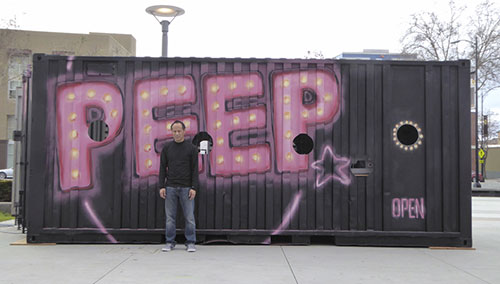
Santa Clara University professor, filmmaker and installation artist Jonathan Fung believes that social engagement and change can be sparked by the arts.
“Art is all about story telling. People connect to art. There’s an instant reaction–emotion is evoked. It causes the viewer to be aware and ask questions about what the work is about,” says Fung, who uses his artistic talents to spread awareness of human trafficking. “Art engages those looking at it.”
Fung’s two new art installations, Coolie and Peep, both focus on human trafficking, a social issue that has been spotlighted in advance Super Bowl 50. Peep is a 20-foot, metal shipping container–symbolic of world trade–that has been converted into an outdoor peep show symbolizing the undercover world of trafficking.
The outside of the shipping container is painted a sophisticated black with “PEEP” written on the sides in large, pink letters. Portholes on the long sides allow passersby to peep inside, where 21 new sewing machines whir and hum, representing laborers in the global garment industry. On the opposite side, 1,600 wooden toy blocks, with yearbook photos of children on them, dangle from the ceiling, representing the loss of innocent children to trafficking.
Peep sits near one end of Parque de los Pobladores (Gore Park), across the street–appropriately–from the downtown San Jose Museum of Quilts and Textiles at the intersection of S. First St. and E. William St. The island park also intersects S. Market Street, and traffic drives by Peep night and day on both sides.
Peep was unveiled February 1 at a news conference organized by its Santa Clara County and city of San Jose sponsors. Participants included Santa Clara County Supervisor Cindy Chavez, District Attorney Jeff Rosen and San Jose Vice Mayor Rose Herrera.
In addition to county and San Jose city funding, Peep received in-kind support from Mobile Mini of Fremont, Able Glass, and Copy Craft. It will be on display through March 12, then tour San Mateo County for the rest of the year.
Coolie, an indoor art installation by Fung, is part of the “Gold Rush” exhibition on view through March 13 at the de Saisset Museum on the campus of Santa Clara University. Coolie represents the unskilled Chinese workers, degradingly called “coolies,” who were forced to build railroads and labor in sweatshops and as prostitutes during the 1849 California gold rush.
The art installation resembles a gold rush shanty with a wooden plank floor and roof. Eight vintage sewing machines are on a low table lighted by three dim, overhead bulbs with shades shaped like a coolie hat.
The treadle sewing machines are threaded with gold thread, representing both good luck and greed. Red silk fabric billows from each. Normally a lucky color in the Chinese culture, in Coolie, red represents the shed blood of the laborers.
“When artists take on different social issues, they express it through their medium and invite the audience to step into that dialogue and ask questions. There is give and take between the audience and artists,” says de Saisset Museum director Rebecca M. Schapp.
“We wanted to make that connection on the issues still with us and just called something new and different. If we can bring awareness to those subjects, hopefully we can all work together to make society better.”
“Human trafficking is a complex criminal industry, and we must utilize a multi-faceted approach to combat it….Art like Peep–and artists like Jonathan Fung–create opportunities for the public to think about human trafficking and then to act,” states Supervisor Chavez. “Remember, if you see something, say something.”
The National Human Trafficking Hotline is (888) 373-7888.





